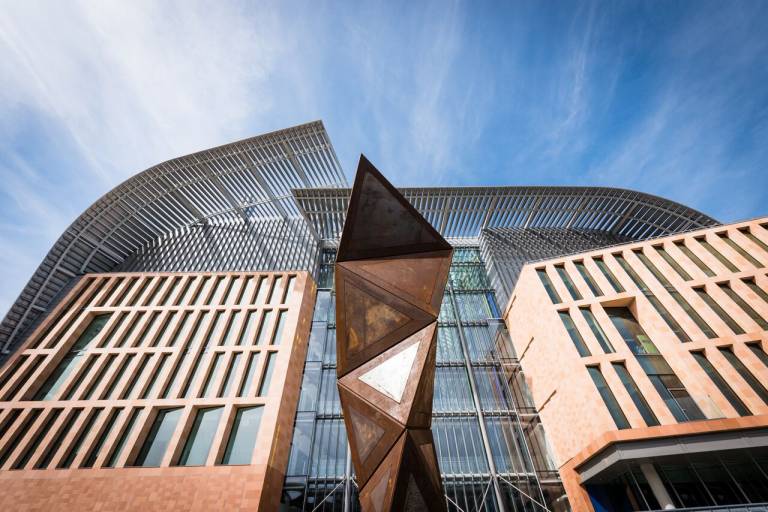Science begins in the new Francis Crick Institute building
1 September 2016
The first scientists have moved into the new £650 million Francis Crick Institute building in London and are starting work in their purpose-built labs.
 Next to St Pancras station
and the British Library, the Crick will be the biggest biomedical research institute
under one roof in Europe.
Next to St Pancras station
and the British Library, the Crick will be the biggest biomedical research institute
under one roof in Europe.
Leading UCL researchers are among the first to move in, including Professor Nicholas Luscombe (UCL Genetics Institute) and Professor Jernej Ule (UCL Institute of Neurology). The Crick has been established through the collaboration of six founding partners: the Medical Research Council (MRC), Cancer Research UK (CRUK), Wellcome, UCL, Imperial College London and King's College London.
Professor Michael Arthur, President and Provost of UCL, said: "The Francis Crick Institute is a once-in-a-generation opportunity for the life and biomedical sciences. Our commitment builds on UCL's role as one of Europe's largest and most successful centres for biomedical research and we are confident it will expand and enhance our already pioneering research. Having the Crick on our doorstep gives us the opportunity to form a world-class biomedical cluster for innovation and excellence in the heart of London. Being a founding partner of the Crick strengthens the translation of our remarkable research into new therapies that benefit human health.
"The unique partnership working catalyzed by the Crick allows us, together, to make the whole more than the sum of its individually excellent parts, allowing us to tackle and overcome some of the biggest global healthcare challenges."
Research groups will continue moving in each week until the end of the year, as lab space is adapted for each group. The start of 2017 will see the Francis Crick Institute up and running with all 1250 scientists and 250 other staff moved in and research projects ramping up.
"We are all extremely excited about being in the new Crick Lab as it's a big step for our group. There is no doubt that the new lab is going to enhance our work," said Professor Jernej Ule. "Firstly, it's going to expand our research capabilities as we're going to have access to the cutting-edge equipment, such as new imaging and biophysical techniques. With the help of experts in these techniques, who are based in the Crick, we will able to take our research to a greater cellular and molecular resolution. I am excited about the prospect of work in partnership between institutes - the UCL Institute of Neurology, where I have been based, and the Crick.
"Secondly, the opportunities the Crick will offer in terms of collaborating with other teams is unprecedented. Our lab will be conveniently based next door to Nicholas Luscombe's research group, who we already work closely with, so we can ensure this work continues. Being co-located with so many other researchers will allow established collaborations to consolidate, as well as forming new ones."

Research at the Crick aims to discover how and why disease develops in order to find new ways to prevent, diagnose and treat conditions such as cancer, heart disease and stroke, infections and neurodegenerative conditions like motor neurone disease.
On 1 April 2015 the MRC's National Institute for Medical Research and CRUK's London Research Institute merged to become the Francis Crick Institute. These research groups are being joined by scientists from UCL, Imperial and King's, who bring with them specialist knowledge, skills and resources across a range of scientific disciplines.
Collaboration and interdisciplinary working is designed into the Crick. Research groups from different disciplines and from different original organisations have been given neighbouring lab space. Coupled with lots of open work space, breakout areas and shared core facilities, this means scientists can't help but bump into each other, have conversations and share ideas. It is all expected to lead to the generation of new insight, research directions and innovations.
The new building is equipped with state-of-the-art facilities for biomedical research. Genetics and genomic studies have access to advanced DNA sequencing, while the latest mass spectrometry equipment allows gene expression, proteins and metabolic pathways to be characterised. Bioinformatics support allows studies involving very large datasets. The robots in the high-throughput screening facility allow tens of thousands of drug candidates to be tested in cells. Electron microscopy, X-ray crystallography and nuclear magnetic resonance suites allow biological structures to be studied in fantastic detail.
The Crick specialises in discovery science: investigating the fundamental biological processes underlying human health and disease. But the increased understanding of these key processes can lead to opportunities to develop novel drugs and innovative new treatments. Translational research - the turning of biological discoveries in the lab into treatments for patients in the clinic - will be a focus for the Crick. For example, the institute has an ongoing partnership with GSK in which teams of scientists from both organisations work side by side in the lab and benefit from the sharing of ideas and approaches in investigating biological systems.
Paul Nurse, Director of the Francis Crick Institute, said: "A remarkable state-of-the-art new home for the Crick has been completed and the occupation by scientists has started. But this is only the beginning. As all our research groups move in over the rest of the year, it will be the discoveries we make here that will establish our place at the forefront of science in London, the UK and worldwide."
Links
- The Francis Crick Institute
- Professor Nicholas Luscombe's academic profile
- Professor Jernej Ule's academic profile
- Medical Research Council
- Cancer Research UK
- Wellcome
Image
- The Francis Crick Institute
Media contact
Harry Dayantis
Tel: +44 (0)20 3108 3844
Email: h.dayantis[at] ucl.ac.uk
 Close
Close

